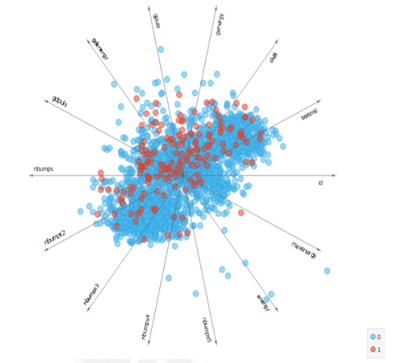Assessment of Seismic Hazards in Underground Mine Operations using Machine Learning
Main Article Content
Abstract
The most common causes of coal mining accidents are seismic hazard, fires, explosions, and landslips. These accidents are usually caused by various factors such as mechanical and technical failures, as well as social and economic factors. An analysis of these accidents can help identify the exact causes of these accidents and prevent them from happening in the future. There are also various seismic events that can occur in underground mines. These include rock bumps and tremors. These have been reported in different countries such as Australia, China, France, Germany, India, Russia, and Poland. Through the use of advanced seismological and seismic monitoring systems, we can now better understand the rock mass processes that can cause a seismic hazard. Unfortunately, despite the advancements, the accuracy of these methods is still not perfect. One of the main factors that prevent the development of effective seismic hazard prediction techniques is the complexity of the seismic processes. In order to carry out effective seismic risk assessment in mines, it is important that the discrimination of seismicity in different regions is carried out. The widespread use of machine learning in analyzing seismic data, it provides reliability and feasibility for preventing major mishaps. This paper provides uses various machine learning classifiers to predict seismic hazards.
Article Details
References
H. He, L. Dou, S. Gong, J. He, Y. Zheng, and X. Zhang, “Microseismic and electromagnetic coupling method for coal bump risk assessment based on dynamic static energy principles,” Saf. Sci., vol. 114, no. October 2018, pp. 30–39, 2019, doi: 10.1016/j.ssci.2018.12.025.
Z. Wen, X. Wang, Y. Tan, H. Zhang, W. Huang, and Q. Li, “A Study of Rockburst Hazard Evaluation Method in Coal Mine,” Shock Vib., vol. 2016, 2016, doi: 10.1155/2016/8740868.
H. Li, A. Cao, S. Gong, C. Wang, and R. Zhang, “Evolution Characteristics of Seismic Detection Probability in Underground Mines and Its Application for Assessing Seismic Risks—A Case Study,” Sensors, vol. 22, no. 10, 2022, doi: 10.3390/s22103682.
L. Sanmiquel, M. Bascompta, J. M. Rossell, H. F. Anticoi, and E. Guash, “Analysis of occupational accidents in underground and surface mining in Spain using data-mining techniques,” Int. J. Environ. Res. Public Health, vol. 15, no. 3, pp. 1–11, 2018, doi: 10.3390/ijerph15030462.
K. Kurach and K. Pawlowski, “Predicting dangerous seismic activity with Recurrent Neural Networks,” Proc. 2016 Fed. Conf. Comput. Sci. Inf. Syst. FedCSIS 2016, vol. 8, pp. 239–243, 2016, doi: 10.15439/2016F134.
Y. Duan, Y. Shen, I. Canbulat, X. Luo, and G. Si, “Classification of clustered microseismic events in a coal mine using machine learning,” J. Rock Mech. Geotech. Eng., vol. 13, no. 6, pp. 1256–1273, 2021, doi: 10.1016/j.jrmge.2021.09.002.
?. Wojtecki, M. J. Mendecki, W. M. Zuberek, and M. Knopik, “An attempt to determine the seismic moment tensor of tremors induced by destress blasting in a coal seam,” Int. J. Rock Mech. Min. Sci., vol. 83, pp. 162–169, 2016, doi: 10.1016/j.ijrmms.2016.01.002.
Y. Jiang, Y. Zhao, H. Wang, and J. Zhu, “A review of mechanism and prevention technologies of coal bumps in China,” J. Rock Mech. Geotech. Eng., vol. 9, no. 1, pp. 180–194, 2017, doi: 10.1016/j.jrmge.2016.05.008.
A. Cao, L. Dou, W. Cai, S. Gong, S. Liu, and G. Jing, “Case study of seismic hazard assessment in underground coal mining using passive tomography,” Int. J. Rock Mech. Min. Sci., vol. 78, pp. 1–9, 2015, doi: 10.1016/j.ijrmms.2015.05.001.
M. Pekar, “Seismic hazard prediction using seismic bumps: a data mining approach,” Am. J. Eng. Res., vol. 2, no. 11, 2016, [Online]. Available: https://www.academia.edu/download/47615341/L050401060111.pdf.
P. L. Swanson, M. S. Boltz, and D. Chambers, “Seismic Monitoring Strategies for Deep Longwall Coal Mines,” 2016.
M. Peker, “Seismic Hazard Prediction Using Seismic Bumps: A Data Mining Approach,” Am. J. Eng. Res., no. 5, pp. 106–111, 2016, [Online]. Available: www.ajer.org.
A. Janusz, D. Slezak, M. Sikora, and L. Wrobel, “Predicting Dangerous Seismic Events: AAIA’16 Data Mining Challenge,” Proc. 2016 Fed. Conf. Comput. Sci. Inf. Syst. FedCSIS 2016, vol. 8, pp. 205–211, 2016, doi: 10.15439/2016F560.
E. Zdravevski, P. Lameski, and A. Kulakov, “Automatic feature engineering for prediction of dangerous seismic activities in coal mines,” Proc. 2016 Fed. Conf. Comput. Sci. Inf. Syst. FedCSIS 2016, vol. 8, pp. 245–248, 2016, doi: 10.15439/2016F152.
M. Sikora and ?. Wróbel, “Application of rule induction algorithms for analysis of data collected by seismic hazard monitoring systems in coal mines,” Arch. Min. Sci., vol. 55, no. 1, pp. 91–114, 2010.

